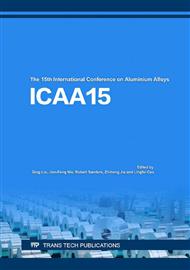p.328
p.334
p.340
p.347
p.356
p.365
p.371
p.380
p.387
Study of Texture in 6016 Aluminum Alloy during Processing
Abstract:
The evolution of texture in AA6016 alloy during processing was systematically investigated. The hot-rolled 6016 plates were cold-rolled to 0.9mm through three different rolling processes. One was directly rolled to 0.9mm, the other two were rolled to 1.8mm and 2.3mm, respectively, followed by intermediate annealing at 360°C for 2h, and then rolled to 0.9mm. Finally, the three kinds of cold rolled plates were performed continuous annealing at 560oC. The textures and microstructures of each stage were characterized by the X-ray diffraction and electron back scattering diffraction (EBSD) techniques. The results show that the texture of hot-rolled sample is mainly composed of Brass, S and Copper; the relative amount and maximum density changed after 1st cold-rolling. After intermediate annealing, the Cube and Cube+ND20 texture replace the deformation texture and rise with the rolling reduction. Then the conducting of final cold rolling results in the decrease of Cube and Cube+ND20 component and increase of deformation texture. After the continuous annealing, R, Brass-R, Goss, Cube and Cube+ND20 components are observed. Particle stimulated nucleation (PSN) and nucleation at shear bands dominate the competition of recrystallization.
Info:
Periodical:
Pages:
356-362
Citation:
Online since:
November 2016
Authors:
Keywords:
Price:
Сopyright:
© 2017 Trans Tech Publications Ltd. All Rights Reserved
Share:
Citation:


